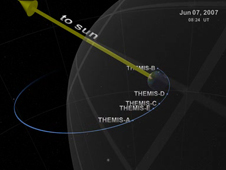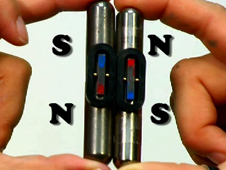Feature
Text Size
Sun Often "Tears Out A Wall" In Earth's Solar Storm Shield
12.16.08
 This animation shows the latest findings from the THEMIS mission. Earth's magnetic field, which shields our planet from severe space weather, often develops two holes when the solar wind's magnetic field points North that allow the largest leaks of solar particles.
Credit: NASA CI Lab/Walt Feimer
This animation shows the latest findings from the THEMIS mission. Earth's magnetic field, which shields our planet from severe space weather, often develops two holes when the solar wind's magnetic field points North that allow the largest leaks of solar particles.
Credit: NASA CI Lab/Walt Feimer> Watch animation (512x288)
> Hi-res stills & video options
 In the early part of the mission, the five THEMIS satellites follow the same orbit single-file. The apogee of the orbit takes the spacecraft just beyond the bow shock of Earth's magnetosphere. This enables the closely spaced satellites to measure the thickness of the different regions that they encounter.
Credit: NASA CI Lab/Tom Bridgman
In the early part of the mission, the five THEMIS satellites follow the same orbit single-file. The apogee of the orbit takes the spacecraft just beyond the bow shock of Earth's magnetosphere. This enables the closely spaced satellites to measure the thickness of the different regions that they encounter.
Credit: NASA CI Lab/Tom Bridgman> Watch animation (512x288)
> Hi-res stills & video options
 NASA's THEMIS mission has overturned a longstanding belief about the interaction between solar particles and Earth's magnetic field.
Credit: NASA
NASA's THEMIS mission has overturned a longstanding belief about the interaction between solar particles and Earth's magnetic field.
Credit: NASA> View streaming video
> Watch video (640x360)
> Video transcript
 Credit: NASA
Credit: NASAEarth's magnetosphere works mostly like a bar magnet:
> Watch video: Bar Magnet
Magnets with opposite polarity attract each other:
> Watch video: Magnets Attract
Magnets with similar polarity repel each other:
> Watch video: Magnets Repel
The magnet in the tube of iron filings has the same magnetic polarity as the Earth. When a bar magnet is placed against the tube, the filings trace out a line:
> Watch video: Filings Earth's magnetic field, which shields our planet from particles streaming outward from the Sun, often develops two holes that allow the largest leaks, according to researchers sponsored by NASA and the National Science Foundation.
"The discovery overturns a long-standing belief about how and when most of the solar particles penetrate Earth's magnetic field, and could be used to predict when solar storms will be severe. Based on these results, we expect more severe storms during the upcoming solar cycle," said Vassilis Angelopoulos of the University of California, Los Angeles, Principal Investigator for NASA's THEMIS mission (Time History of Events and Macroscale Interactions during Substorms). THEMIS was used to discover the size of the leak.
Earth’s magnetic field acts as a shield against the bombardment of particles continuously streaming from the sun. Because the solar particles (ions and electrons) are electrically charged, they feel magnetic forces and most are deflected by our planet's magnetic field. However, our magnetic field is a leaky shield and the number of particles breaching this shield depends on the orientation of the sun’s magnetic field. It had been thought that when the sun’s magnetic field is aligned with that of the Earth, the door is shut and that few if any solar particles enter Earth’s magnetic shield. The door was thought to open up when the solar magnetic field direction points opposite to Earth’s field, leading to more solar particles inside the shield.
Surprisingly, recent observations by the THEMIS spacecraft fleet demonstrate that the opposite is true. "Twenty times more solar particles cross the Earth’s leaky magnetic shield when the sun’s magnetic field is aligned with that of the Earth compared to when the two magnetic fields are oppositely directed," said Marit Oieroset of the University of California, Berkeley, lead author of one of two papers on this research, published May 2008 in Geophysical Research Letters.
Researchers have long suspected that this "closed door" entry mechanism might exist, but didn’t know how important it was. "It's as if people knew there was a crack in a levy, but they did not know how much flooding it caused," said Oieroset.
Previous spacecraft could only sample a small part of this enormous layer of solar particles inside the Earth’s magnetic shield, but the five spacecraft in the THEMIS fleet spanned the entire rapidly-growing layer to give definitive measurements.
While the THEMIS researchers discovered the size of the leak, they didn't know its location(s). This was discovered by Wenhui Li of the University of New Hampshire, Durham, N.H., and his team. They used a computer simulation to discover where two holes frequently develop in Earth's magnetic field, one at high latitude over the Northern hemisphere, and one at high latitude over the Southern hemisphere. The holes form over the daylit side of Earth, on the side of the magnetic shield facing the sun.
The simulation also showed how the leaks develop. As solar particles flow out from the sun, they carry solar magnetic fields past our planet. Li's team realized that the solar magnetic field drapes against Earth's field as it passes by. Even though the two fields point in the same direction at equatorial latitudes, they point in opposite directions at high latitudes, When compression forces the opposite fields together, they link up with each other in a process called magnetic reconnection. This process tears the two holes in Earth's magnetic field and appends the section of the solar field between the two holes to Earth's field, carrying the solar particles on this section into the magnetosphere, according to Li's team. "We've found if the door is closed, the sun tears down a wall. The crack is huge – about four times wider than Earth and more then seven Earth diameters long," said Li, whose paper will be published in an upcoming article of the Journal of Geophysical Research.
Solar particles by themselves don't cause severe space weather, but they get energized when the solar magnetic field becomes oppositely-directed to Earth's and reconnects in a different way. The energized particles then cause magnetic storms that can overload power lines with excess current, causing widespread blackouts. The particles also can cause radiation storms that present hazards to spacecraft in high orbits and astronauts passing through the storms on the way to the moon or other destinations in the solar system. "The more particles, the more severe the storm," said Joachim "Jimmy" Raeder of the University of New Hampshire, a co-author of Li's paper. "If the solar field has been aligned with the Earth's for a while, we now know Earth's field is heavily loaded with solar particles and primed for a strong storm. This discovery gives us a basic predictive capability for the severity of solar storms, similar to a hurricane forecaster's realization that warmer oceans set the stage for more intense hurricanes. In fact, we expect stronger storms in the upcoming solar cycle. The sun's magnetic field changes direction every cycle, and due to its new orientation in the upcoming cycle, we expect the clouds of particles ejected from the sun will have a field which is at first aligned with Earth, then becomes opposite as the cloud passes by."
Press briefing materials:
> Press briefing PDF
NASA Goddard Space Flight Center